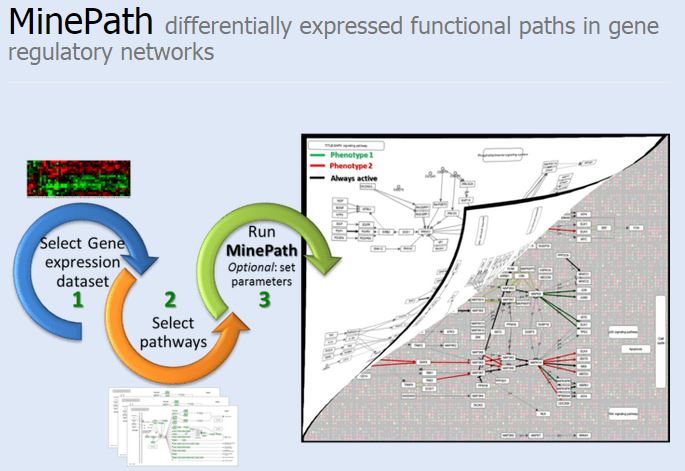One of our pride points for being able to pool, standardize, and share gene, variant, and other “BioThings” annotation data as a service, is that our service is fast! The reason that MyGene.info and MyVariant.info are made with speed in mind is that we want them to be useful to bioinformaticians and tool/resource developers alike! How can we tell if we’ve successfully provided a useful service?
One measure we LOVE, is when a user builds something useful or amazing with our service. Today we’d like to introduce MinePath which is an online pathway analysis tool. One thing we love about MinePath is how it leverages existing interoperable REST-based services to provide a flexible, interactive, and intuitive pathway analysis and visualization tool. MinePath is supported by the Computational BioMedicine Laboratory (CBML), Institute of Computer Science (ICS), Foundation for Research and Technology - Hellas (FORTH). Dr. Lefteris Koumakis, an author of MinePath was kind enough to answer our questions.
In one tweet or less, introduce us to MinePath:
Minepath is a web-based platform that elaborates on, and radically extends the identification of differentially expressed sub-paths in molecular pathways.
What was the original intent behind MinePath (how did the MinePath team first come to identify the deficiencies in existing pathway analysis and visualization tools and come up with the strategy to overcome these deficiencies)?
One of the main limitations back then was the visualization capabilities of the pathway analysis tools. We already had our in-house algorithm for pathway analysis but still the interpretation of the results required too much effort for a biologist. The first step was to design a responsive online tool capable to visualize differentially expressed sub-pathways and not only gene expressions on a gene regulatory network. Furthermore, we wanted to visualize the always functional parts of a network, since such parts can link the gap between two discriminant sub-pathways, a feature that all the pathway visualization tools neglected. Then the challenge was to create an online and real time pathway analysis tool, so we optimized our algorithm to analyze RNA-seq data in less than a minute and we integrated the rest services of mygene.info in order to provide a fast annotation tool to link the uploaded probe-sets to Entrez gene identifiers.
How has MinePath since improved (key improvements, not just GitHub commits)?
Now MinePath supports RNA-seq data and has been extended to provide information for targeted genes or gene groups regarding the corresponding: drug targets (the KEGG DRUG DB rest-service is utilized); miRNA targets, transcription factor targets and gene signatures from MSigDB and gene variants and associated drugs from PharmGKB.
Who is currently the intended audience for MinePath?
Bioinformaticians, Geneticists and Biologists
How does MinePath use MyGene.info or MyVariant.info services?
Minepath uses the MyGene.info rest service for the annotation of the (uploaded) expression data to KEGG ids. MyGene.info is the fastest annotator for such processes and allow us to provide a complete pathway analysis pipeline (including the annotation) in a couple of minutes. We are using the rest services for bulk annotation (~20.000 annotations per run).
What are some of MinePath’s successes (news releases, papers published)?
Last year, there was an average of 100 users per month. An average of 140 analysis were run per month, and an average of 45 datasets were privately uploaded and analyzed on a monthly basis. In 2017, MinePath was voted one of the top 5 tools in the LabWorm weekly rankings for October.
There have been two publications on MinePath since 2016:
Lefteris Koumakis, Panos Roussos, George Potamias; minepath.org: a free interactive pathway analysis web server. Nucleic Acids Res 2017; 45 (W1): W116-W121. doi: 10.1093/nar/gkx278
Lefteris Koumakis, Alexandros Kanterakis, Evgenia Kartsaki, Maria Chatzimina, Michalis Zervakis, Manolis Tsiknakis, Despoina Vassou et al. "MinePath: mining for phenotype differential sub-paths in molecular pathways." PLoS computational biology 12, no. 11 (2016): e1005187.
What improvements are planned for MinePath?
We plan to extend the functionality of the methodology and support co-analysis of heterogeneous data including gene variants (SNPs, Indels) as well as other genome alterations (e.g., copy number variations /CNVs). We believe that holistic approaches and co-analysis of heterogeneous multilayered data are necessary to allow for the comprehensive supervision and monitoring of the respective omic data and for the related scientific findings.

